Issues surrounding Yonsei’s new course registration system
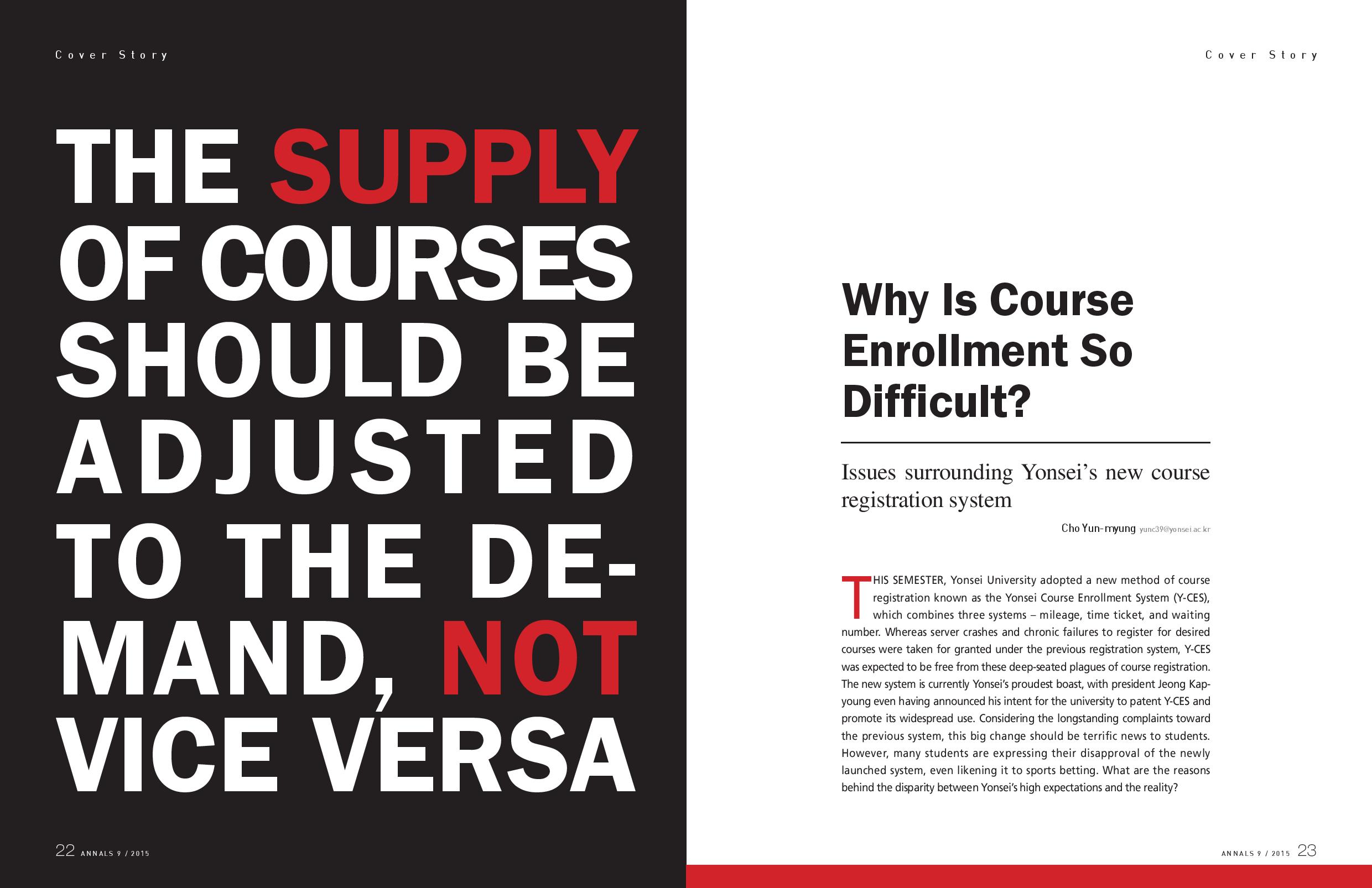
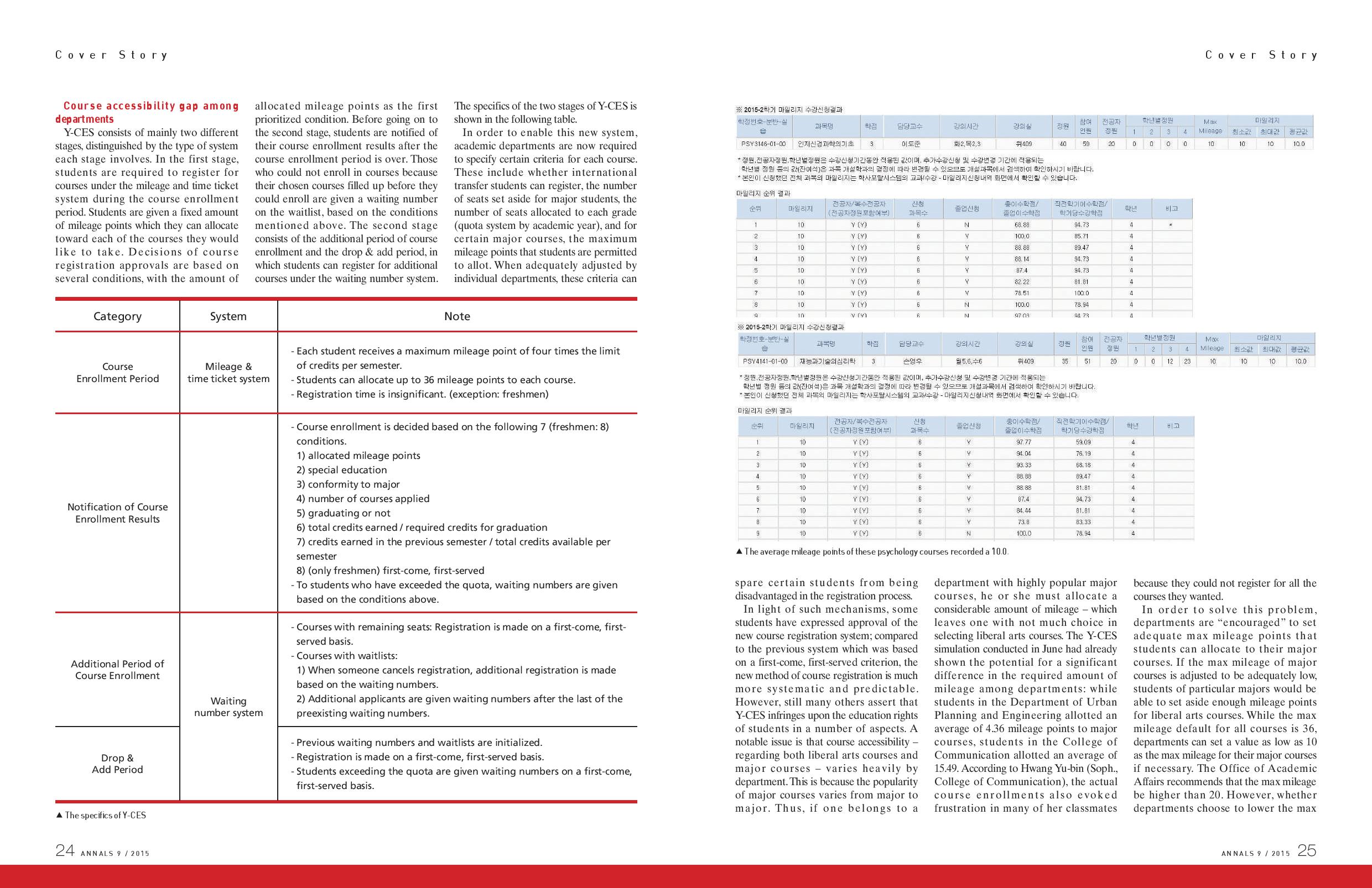
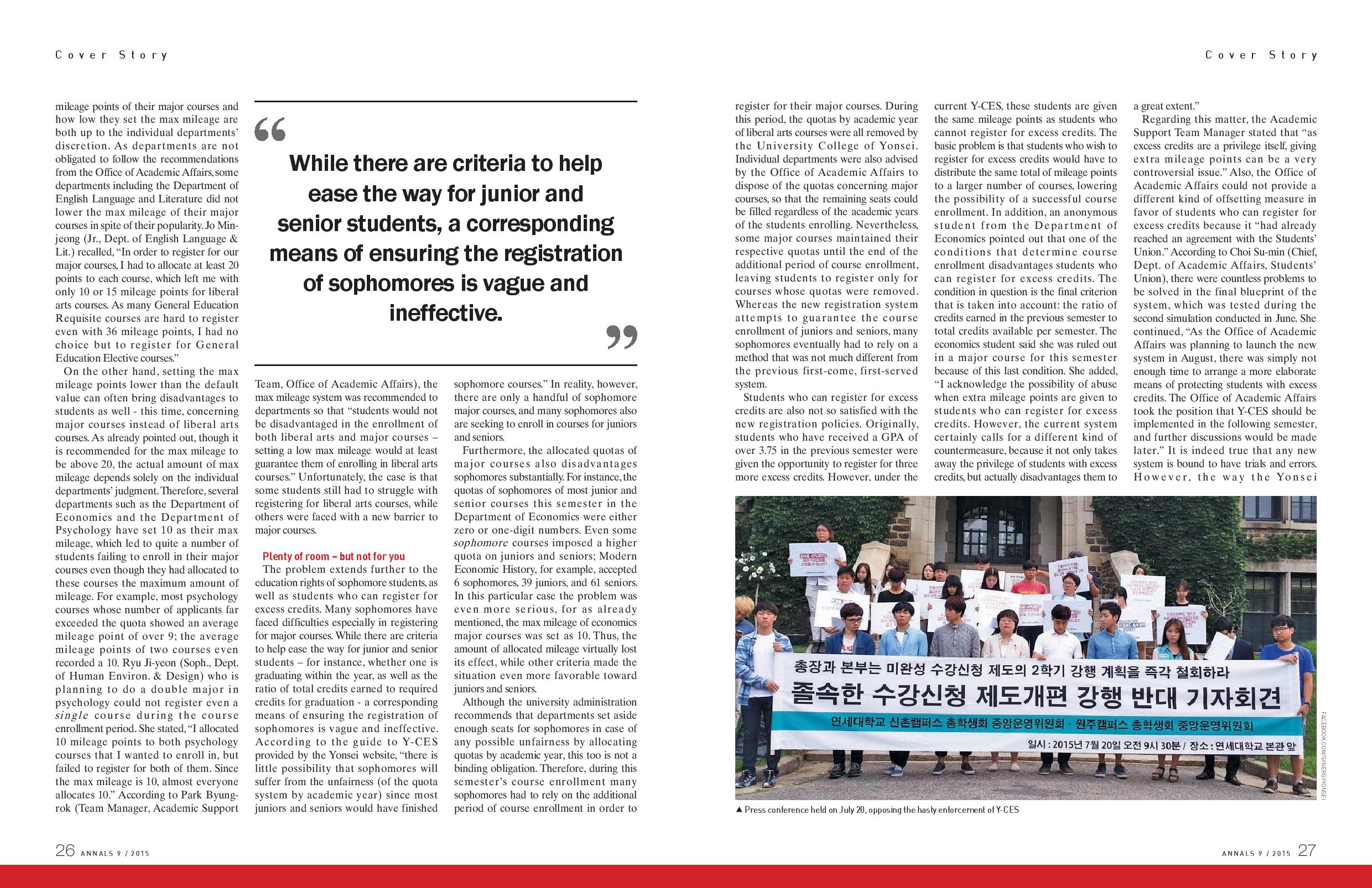
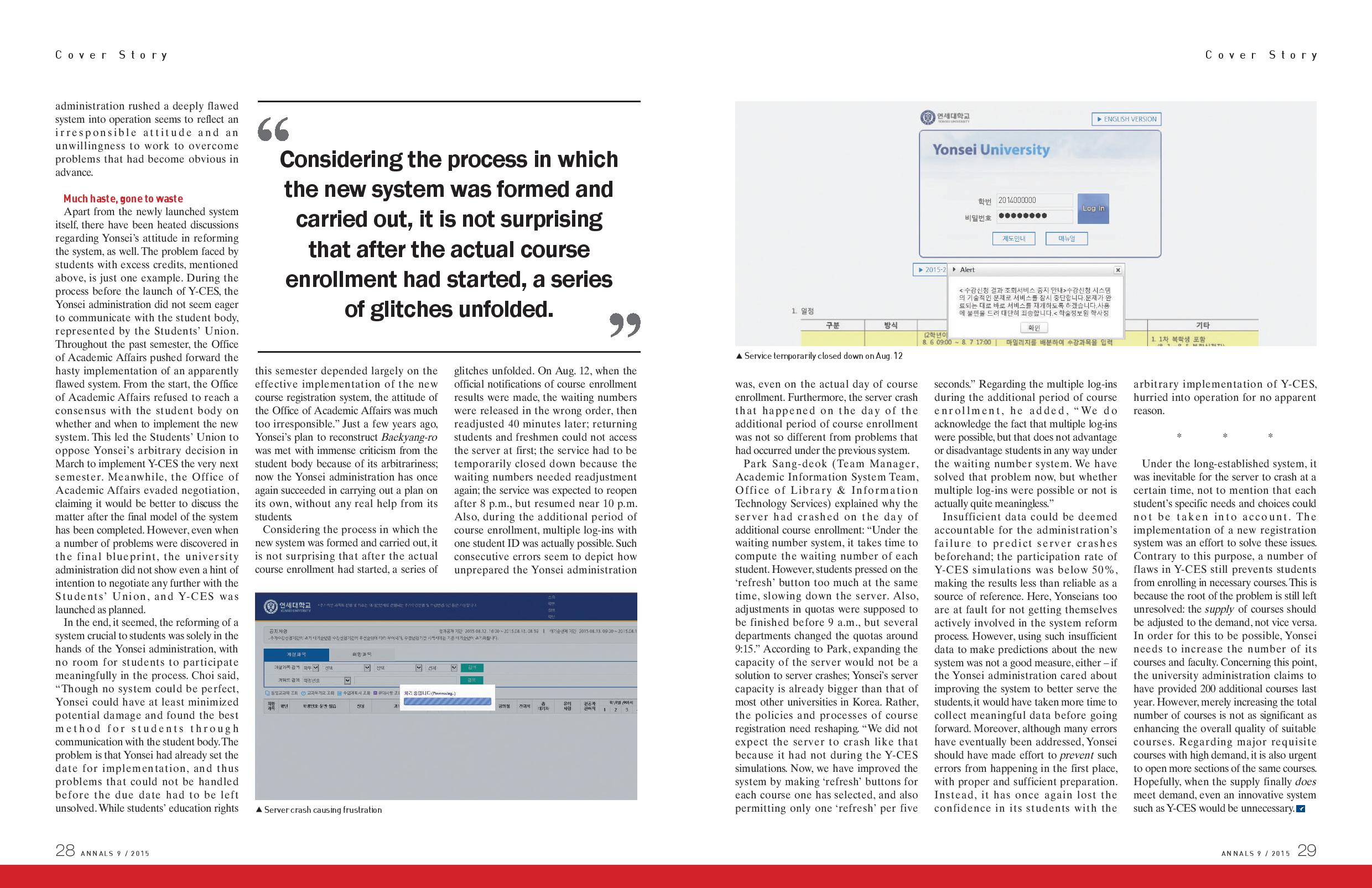
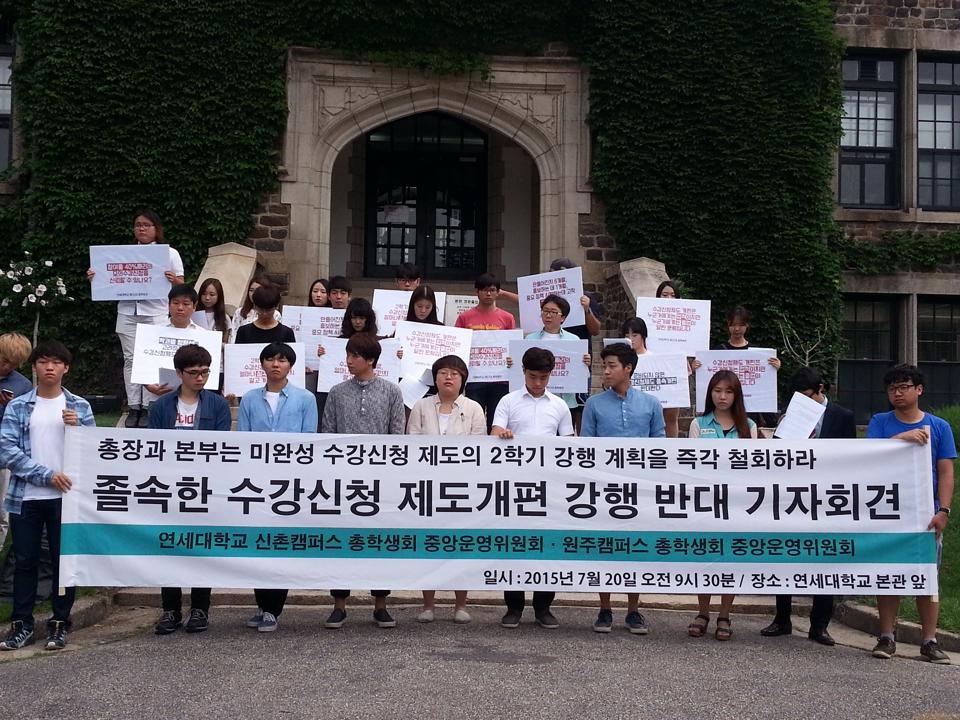
THIS SEMESTER, Yonsei University adopted a new method of course registration known as the Yonsei Course Enrollment System (Y-CES), which combines three systems – mileage, time ticket, and waiting number. Whereas server crashes and chronic failures to register for desired courses were taken for granted under the previous registration system, Y-CES was expected to be free from these deep-seated plagues of course registration. The new system is currently Yonsei’s proudest boast, with president Jeong Kap-young even having announced his intent for the university to patent Y-CES and promote its widespread use. Considering the longstanding complaints toward the previous system, this big change should be terrific news to students. However, many students are expressing their disapproval of the newly launched system, even likening it to sports betting. What are the reasons behind the disparity between Yonsei’s high expectations and the reality?
Course accessibility gap among departments
Y-CES consists of mainly two different stages, distinguished by the type of system each stage involves. In the first stage, students are required to register for courses under the mileage and time ticket system during the course enrollment period. Students are given a fixed amount of mileage points which they can allocate toward each of the courses they would like to take. Decisions of course registration approvals are based on several conditions, with the amount of allocated mileage points as the first prioritized condition. Before going on to the second stage, students are notified of their course enrollment results after the course enrollment period is over. Those who could not enroll in courses because their chosen courses filled up before they could enroll are given a waiting number on the waitlist, based on the conditions mentioned above. The second stage consists of the additional period of course enrollment and the drop & add period, in which students can register for additional courses under the waiting number system. The specifics of the two stages of Y-CES is shown in the following table.
In order to enable this new system, academic departments are now required to specify certain criteria for each course. These include whether international transfer students can register, the number of seats set aside for major students, the number of seats allocated to each grade (quota system by academic year), and for certain major courses, the maximum mileage points that students are permitted to allot. When adequately adjusted by individual departments, these criteria can spare certain students from being disadvantaged in the registration process.
In light of such mechanisms, some students have expressed approval of the new course registration system; compared to the previous system which was based on a first-come, first-served criterion, the new method of course registration is much more systematic and predictable. However, still many others assert that Y-CES infringes upon the education rights of students in a number of aspects. A notable issue is that course accessibility – regarding both liberal arts courses and major courses – varies heavily by department. This is because the popularity of major courses varies from major to major. Thus, if one belongs to a department with highly popular major courses, he or she must allocate a considerable amount of mileage – which leaves one with not much choice in selecting liberal arts courses. The Y-CES simulation conducted in June had already shown the potential for a significant difference in the required amount of mileage among departments: while students in the Department of Urban Planning and Engineering allotted an average of 4.36 mileage points to major courses, students in the College of Communication allotted an average of 15.49. According to Hwang Yu-bin (Soph., College of Communication), the actual course enrollments also evoked frustration in many of her classmates because they could not register for all the courses they wanted.
In order to solve this problem, departments are “encouraged” to set adequate max mileage points that students can allocate to their major courses. If the max mileage of major courses is adjusted to be adequately low, students of particular majors would be able to set aside enough mileage points for liberal arts courses. While the max mileage default for all courses is 36, departments can set a value as low as 10 as the max mileage for their major courses if necessary. The Office of Academic Affairs recommends that the max mileage be higher than 20. However, whether departments choose to lower the max mileage points of their major courses and how low they set the max mileage are both up to the individual departments’ discretion. As departments are not obligated to follow the recommendations from the Office of Academic Affairs, some departments including the Department of English Language and Literature did not lower the max mileage of their major courses in spite of their popularity. Jo Min-jeong (Jr., Dept. of English Language & Lit.) recalled, “In order to register for our major courses, I had to allocate at least 20 points to each course, which left me with only 10 or 15 mileage points for liberal arts courses. As many General Education Requisite courses are hard to register even with 36 mileage points, I had no choice but to register for General Education Elective courses.”
On the other hand, setting the max mileage points lower than the default value can often bring disadvantages to students as well - this time, concerning major courses instead of liberal arts courses. As already pointed out, though it is recommended for the max mileage to be above 20, the actual amount of max mileage depends solely on the individual departments’ judgment. Therefore, several departments such as the Department of Economics and the Department of Psychology have set 10 as their max mileage, which led to quite a number of students failing to enroll in their major courses even though they had allocated to these courses the maximum amount of mileage. For example, most psychology courses whose number of applicants far exceeded the quota showed an average mileage point of over 9; the average mileage points of two courses even recorded a 10. Ryu Ji-yeon (Soph., Dept. of Human Environ. & Design) who is planning to do a double major in psychology could not register even a single course during the course enrollment period. She stated, “I allocated 10 mileage points to both psychology courses that I wanted to enroll in, but failed to register for both of them. Since the max mileage is 10, almost everyone allocates 10.” According to Park Byung-rok (Team Manager, Academic Support Team, Office of Academic Affairs), the max mileage system was recommended to departments so that “students would not be disadvantaged in the enrollment of both liberal arts and major courses – setting a low max mileage would at least guarantee them of enrolling in liberal arts courses.” Unfortunately, the case is that some students still had to struggle with registering for liberal arts courses, while others were faced with a new barrier to major courses.
Plenty of room – but not for you
The problem extends further to the education rights of sophomore students, as well as students who can register for excess credits. Many sophomores have faced difficulties especially in registering for major courses. While there are criteria to help ease the way for junior and senior students – for instance, whether one is graduating within the year, as well as the ratio of total credits earned to required credits for graduation - a corresponding means of ensuring the registration of sophomores is vague and ineffective. According to the guide to Y-CES provided by the Yonsei website, “there is little possibility that sophomores will suffer from the unfairness (of the quota system by academic year) since most juniors and seniors would have finished sophomore courses.” In reality, however, there are only a handful of sophomore major courses, and many sophomores also are seeking to enroll in courses for juniors and seniors.
Furthermore, the allocated quotas of major courses also disadvantages sophomores substantially. For instance, the quotas of sophomores of most junior and senior courses this semester in the Department of Economics were either zero or one-digit numbers. Even some sophomore courses imposed a higher quota on juniors and seniors; Modern Economic History, for example, accepted 6 sophomores, 39 juniors, and 61 seniors. In this particular case the problem was even more serious, for as already mentioned, the max mileage of economics major courses was set as 10. Thus, the amount of allocated mileage virtually lost its effect, while other criteria made the situation even more favorable toward juniors and seniors.
Although the university administration recommends that departments set aside enough seats for sophomores in case of any possible unfairness by allocating quotas by academic year, this too is not a binding obligation. Therefore, during this semester’s course enrollment many sophomores had to rely on the additional period of course enrollment in order to register for their major courses. During this period, the quotas by academic year of liberal arts courses were all removed by the University College of Yonsei. Individual departments were also advised by the Office of Academic Affairs to dispose of the quotas concerning major courses, so that the remaining seats could be filled regardless of the academic years of the students enrolling. Nevertheless, some major courses maintained their respective quotas until the end of the additional period of course enrollment, leaving students to register only for courses whose quotas were removed. Whereas the new registration system attempts to guarantee the course enrollment of juniors and seniors, many sophomores eventually had to rely on a method that was not much different from the previous first-come, first-served system.
Students who can register for excess credits are also not so satisfied with the new registration policies. Originally, students who have received a GPA of over 3.75 in the previous semester were given the opportunity to register for three more excess credits. However, under the current Y-CES, these students are given the same mileage points as students who cannot register for excess credits. The basic problem is that students who wish to register for excess credits would have to distribute the same total of mileage points to a larger number of courses, lowering the possibility of a successful course enrollment. In addition, an anonymous student from the Department of Economics pointed out that one of the conditions that determine course enrollment disadvantages students who can register for excess credits. The condition in question is the final criterion that is taken into account: the ratio of credits earned in the previous semester to total credits available per semester. The economics student said she was ruled out in a major course for this semester because of this last condition. She added, “I acknowledge the possibility of abuse when extra mileage points are given to students who can register for excess credits. However, the current system certainly calls for a different kind of countermeasure, because it not only takes away the privilege of students with excess credits, but actually disadvantages them to a great extent.”
Regarding this matter, the Academic Support Team Manager stated that “as excess credits are a privilege itself, giving extra mileage points can be a very controversial issue.” Also, the Office of Academic Affairs could not provide a different kind of offsetting measure in favor of students who can register for excess credits because it “had already reached an agreement with the Students’ Union.” According to Choi Su-min (Chief, Dept. of Academic Affairs, Students’ Union), there were countless problems to be solved in the final blueprint of the system, which was tested during the second simulation conducted in June. She continued, “As the Office of Academic Affairs was planning to launch the new system in August, there was simply not enough time to arrange a more elaborate means of protecting students with excess credits. The Office of Academic Affairs took the position that Y-CES should be implemented in the following semester, and further discussions would be made later.” It is indeed true that any new system is bound to have trials and errors. However, the way the Yonsei administration rushed a deeply flawed system into operation seems to reflect an irresponsible attitude and an unwillingness to work to overcome problems that had become obvious in advance.
Much haste, gone to waste
Apart from the newly launched system itself, there have been heated discussions regarding Yonsei’s attitude in reforming the system, as well. The problem faced by students with excess credits, mentioned above, is just one example. During the process before the launch of Y-CES, the Yonsei administration did not seem eager to communicate with the student body, represented by the Students’ Union. Throughout the past semester, the Office of Academic Affairs pushed forward the hasty implementation of an apparently flawed system. From the start, the Office of Academic Affairs refused to reach a consensus with the student body on whether and when to implement the new system. This led the Students’ Union to oppose Yonsei’s arbitrary decision in March to implement Y-CES the very next semester. Meanwhile, the Office of Academic Affairs evaded negotiation, claiming it would be better to discuss the matter after the final model of the system has been completed. However, even when a number of problems were discovered in the final blueprint, the university administration did not show even a hint of intention to negotiate any further with the Students’ Union, and Y-CES was launched as planned.
In the end, it seemed, the reforming of a system crucial to students was solely in the hands of the Yonsei administration, with no room for students to participate meaningfully in the process. Choi said, “Though no system could be perfect, Yonsei could have at least minimized potential damage and found the best method for students through communication with the student body. The problem is that Yonsei had already set the date for implementation, and thus problems that could not be handled before the due date had to be left unsolved. While students’ education rights this semester depended largely on the effective implementation of the new course registration system, the attitude of the Office of Academic Affairs was much too irresponsible.” Just a few years ago, Yonsei’s plan to reconstruct Baekyang-ro was met with immense criticism from the student body because of its arbitrariness; now the Yonsei administration has once again succeeded in carrying out a plan on its own, without any real help from its students.
Considering the process in which the new system was formed and carried out, it is not surprising that after the actual course enrollment had started, a series of glitches unfolded. On Aug. 12, when the official notifications of course enrollment results were made, the waiting numbers were released in the wrong order, then readjusted 40 minutes later; returning students and freshmen could not access the server at first; the service had to be temporarily closed down because the waiting numbers needed readjustment again; the service was expected to reopen after 8 p.m., but resumed near 10 p.m. Also, during the additional period of course enrollment, multiple log-ins with one student ID was actually possible. Such consecutive errors seem to depict how unprepared the Yonsei administration was, even on the actual day of course enrollment. Furthermore, the server crash that happened on the day of the additional period of course enrollment was not so different from problems that had occurred under the previous system.
Park Sang-deok (Team Manager, Academic Information System Team, Office of Library & Information Technology Services) explained why the server had crashed on the day of additional course enrollment: “Under the waiting number system, it takes time to compute the waiting number of each student. However, students pressed on the ‘refresh’ button too much at the same time, slowing down the server. Also, adjustments in quotas were supposed to be finished before 9 a.m., but several departments changed the quotas around 9:15.” According to Park, expanding the capacity of the server would not be a solution to server crashes; Yonsei’s server capacity is already bigger than that of most other universities in Korea. Rather, the policies and processes of course registration need reshaping. “We did not expect the server to crash like that because it had not during the Y-CES simulations. Now, we have improved the system by making ‘refresh’ buttons for each course one has selected, and also permitting only one ‘refresh’ per five seconds.” Regarding the multiple log-ins during the additional period of course enrollment, he added, “We do acknowledge the fact that multiple log-ins were possible, but that does not advantage or disadvantage students in any way under the waiting number system. We have solved that problem now, but whether multiple log-ins were possible or not is actually quite meaningless.”
Insufficient data could be deemed accountable for the administration’s failure to predict server crashes beforehand; the participation rate of Y-CES simulations was below 50%, making the results less than reliable as a source of reference. Here, Yonseians too are at fault for not getting themselves actively involved in the system reform process. However, using such insufficient data to make predictions about the new system was not a good measure, either – if the Yonsei administration cared about improving the system to better serve the students, it would have taken more time to collect meaningful data before going forward. Moreover, although many errors have eventually been addressed, Yonsei should have made effort to prevent such errors from happening in the first place, with proper and sufficient preparation. Instead, it has once again lost the confidence in its students with the arbitrary implementation of Y-CES, hurried into operation for no apparent reason.
* * *
Under the long-established system, it was inevitable for the server to crash at a certain time, not to mention that each student’s specific needs and choices could not be taken into account. The implementation of a new registration system was an effort to solve these issues. Contrary to this purpose, a number of flaws in Y-CES still prevents students from enrolling in necessary courses. This is because the root of the problem is still left unresolved: the supply of courses should be adjusted to the demand, not vice versa. In order for this to be possible, Yonsei needs to increase the number of its courses and faculty. Concerning this point, the university administration claims to have provided 200 additional courses last year. However, merely increasing the total number of courses is not as significant as enhancing the overall quality of suitable courses. Regarding major requisite courses with high demand, it is also urgent to open more sections of the same courses. Hopefully, when the supply finally does meet demand, even an innovative system such as Y-CES would be unnecessary.
| Category | System | Note |
| Course Enrollment Period | Mileage & time ticket system | - Each student receives a maximum mileage point of four times the limit of credits per semester. - Students can allocate up to 36 mileage points to each course. - Registration time is insignificant. (exception: freshmen) |
| Notification of Course Enrollment Results | | - Course enrollment is decided based on the following 7 (freshmen: 8) conditions. 1) allocated mileage points 2) special education 3) conformity to major 4) number of courses applied 5) graduating or not 6) total credits earned / required credits for graduation 7) credits earned in the previous semester / total credits available per semester 8) (only freshmen) first-come, first-served - To students who have exceeded the quota, waiting numbers are given based on the conditions above. |
| Additional Period of Course Enrollment | Waiting number system | - Courses with remaining seats: Registration is made on a first-come, first-served basis. - Courses with waitlists: 1) When someone cancels registration, additional registration is made based on the waiting numbers. 2) Additional applicants are given waiting numbers after the last of the preexisting waiting numbers. |
| Drop & Add Period | Waiting number system | - Previous waiting numbers and waitlists are initialized. - Registration is made on a first-come, first-served basis. - Students exceeding the quota are given waiting numbers on a first-come, first-served basis. |
Box 1: The specifics of Y-CES
Cho Yun-myung
yunc39@yonsei.ac.kr

